I’ve noticed last week that the blog has no post on piled foundation and decided to write a couple of words on the topic on a flight back to Hamburg.
Piled foundations is a broad term that include several technical solution aimed at increasing the bearing capacity of the soil when design requirements such as bearing capacity, limited differential settlement and/or necessary rotational stiffness can’t be met designing a standard shallow foundation.
Piled foundation are a type of “deep foundation”, a concept opposed to the standard “shallow foundation” solution – other type of deep foundation solutions are for instance soil substitution and soil injections.
They are relatively frequent. The number of piled foundation that you will see are very dependent on the countries you are working in – probably almost 100% of the new WTGs in the Nederland are piled, while turbines installed in Portugal on the top of a mountain ridge are usually on a shallow foundation.
Piled foundation are usually expensive – as a rule of thumb, they can cost between 1.5 and 2.5 times the cost of a standard shallow foundation for the same turbine type.
The selection of a solution will usually depend on 2 main criteria:
- Cost: unsurprisingly, the main concern is usually to limit the impact of special foundations on the project budget.
- Constructability: sometimes the “best” solution can’t be selected due for instance to a shortage of machinery (a problem more frequent that you might think, above all in good times of strong economic growth), environmental constraints or other potential impacts (for instance, some piles are hammered and they can induce vibration on other building and structures nearby).
The main categories of piles are
Precast piles: this solution use concrete (or more infrequently, steel) piles fabricated somewhere else. Piles are driven into the ground by a hammering machine that measure the resistance of the soil to each blow. They say that “a driven pile is a tested pile” – and if you are not reaching the needed capacity you can keep hammering the pile to a greater depth as they are modular. Precast piles are usually more expensive and as mentioned they generate noise and vibrations.
In situ piles: this type of piles are fabricated on the spot. Augercast piles, also known as continuous flight auger piles, are drilled by a machinery that first drill the hole to the requested depth and after, while retracting the auger, inject cement ground in the ground. After concrete reinforcement bars are inserted in the pile. Drilled piles are similar – first the hole is drilled, after the walls of the excavation are kept into place using a fluid like bentonite or a steel casing. After, as in the previous case, concrete is pumped and concrete bars are inserted in the hole. The last type are rammed aggregate piles (also called impact piers), where instead of concrete gravel is inserted in the hole and after hammered by the machine. By doing so a higher density is achieved for the gravel and for the soil around it. This solution is specially effective in seismic areas, were concrete piles can be broken by earthquake.
The pictures above are coming from a wind farm I’ve worked at many, many years ago (I think it was called Zarzuela, with 22x V90 2MW… now the WTGs in the market are over 4 MW!).
The piles shown were done by a company called Rodio Kronsa.
If I remember correctly they were built pumping directly the concrete, without bentonite. The concrete was pumped from a central pipe, while in parallel the earth was extract by the rotatory driller (basically, a huge Archimedes’ screw).
After, the reinforcement bars were inserted.
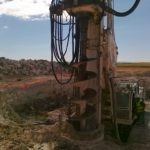
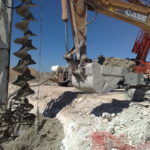
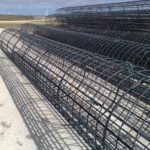
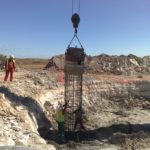
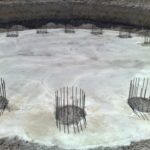
Leave a Reply